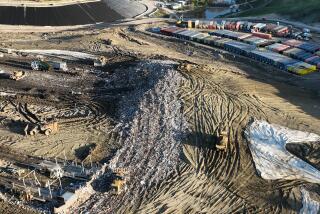Activist Revives Suit Over Basin’s Smog Plan
A federal suit charging that the U.S. Environmental Protection Agency was not tough enough when it approved an air pollution control plan for the South Coast Air Basin was reopened Friday by an environmental activist.
Mark Abramowitz of Los Angeles said Friday that he decided to proceed with the suit, which was originally filed in September, 1984, because out-of-court negotiations aimed at getting the EPA to require additional air pollution controls have broken down.
In a brief filed Friday in the U.S. 9th Circuit Court of Appeals in San Francisco, Abramowitz said that the EPA approved the South Coast Air Quality Management District’s plan in July, 1984, even though the plan failed to comply with federal Clean Air Act requirements.
Seeks Reminder
“The act does not give the agency this discretion, and the court must firmly remind it that Congress, not political sensibilities or administrative convenience, must govern its actions,” Abramowitz said in the brief.
Specifically, Abramowitz’s suit said that, contrary to federal law, the district’s plan failed to show that the South Coast Basin would meet federal standards for ozone (commonly known as photochemical smog) and carbon monoxide by December, 1987.
The EPA said it had not yet seen the brief and could not comment.
Developments in the case are expected to be watched closely across the country by officials in other urban areas, lawmakers and environmental groups. The EPA has said that the nation’s smoggest cities, with a third of the U.S. population, will fail to meet the 1987 deadline.
Facing a Dilemma
EPA Administrator Lee M. Thomas and others have long complained that the Clean Air Act presents them with an all-or-nothing dilemma--either urban areas must meet the December, 1987, deadline, or the EPA must impose economic sanctions or preempt local controls by imposing its own air quality rules. Such a course, the EPA has argued, would severely penalize areas that have tried to meet the standards and cause economic disruptions not intended by Congress.
Thus, the EPA has attempted to fashion an administrative approach that will allow these areas to miss the deadline while imposing extra controls.
The EPA has previously admitted in public statements that it is on shaky legal grounds and has asked Congress for a legislative solution.
Abramowitz, who has stepped down as project director for the Santa Monica-based Coalition for Clean Air but who remains on the group’s board of directors, said he recognized that urban areas like the South Coast basin would be hard-pressed to meet the December, 1987, deadline for achieving the ozone and carbon monoxide standards.
Hopes for Settlement
For that reason, he said, he agreed to attempt to reach an out-of-court settlement under which the deadlines would be temporarily waived but the EPA would require the South Coast district to impose additional air pollution controls, known as the “reasonable extra efforts program,” or REEP.
On Friday, however, he said the extra efforts agreed to by the EPA had fallen far short of what was required.
He said he was particularly disturbed by the failure to require incentives to promote alternative clean-burning fuels, ride-sharing programs, and additional controls on oil refineries.
More to Read
Sign up for Essential California
The most important California stories and recommendations in your inbox every morning.
You may occasionally receive promotional content from the Los Angeles Times.










